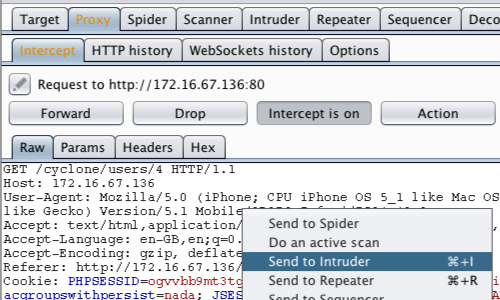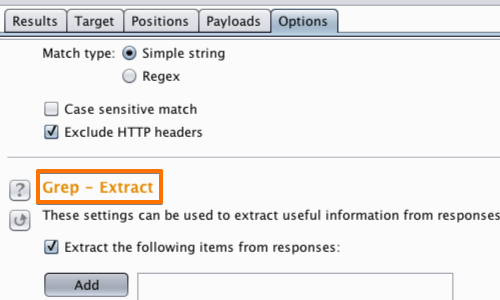A direct object reference occurs when a developer exposes a reference to an internal implementation object, such as a file, directory, database record, or key, as a URL or form parameter. An attacker can manipulate direct object references to access other objects without authorization, unless an access control check is in place.
In our example the application’s authentication / authorization functionality does not prevent one user from gaining access to another user's data or record by modifying the key value identifying the data.
In this example we will demonstrate how to use Burp Intruder and Repeater to check for insecure direct object reference vulnerabilities. This tutorial uses an exercise from the “Cyclone” training tool. The version of “Cyclone” we are using is taken from OWASP’s Broken Web Application Project. Find out how to download, install and use this project.

First, ensure that Burp is correctly configured with your browser.
With intercept turned off in the Proxy "Intercept" tab, visit the web application you are testing in your browser.

Visit the page of the web application you are going to attack.
In this example log in to "Cyclone" using the login details provided on the homepage.
Then click the "My Bank Accounts" link from the "Account" drop down menu.

Return to Burp.
In the Proxy "Intercept" tab, ensure "Intercept is on".
In your browser, reload the page.
The request will be captured by Burp.

View the request in the Proxy “Intercept” tab.
Right click on the raw request to bring up the context menu.
Click “Send to Intruder.”
Note: You can also send requests to Intruder via the context menu in any location where HTTP requests are shown, such as the site map or Proxy history.

Go to the “Intruder” tab, then the “Positions” tab.
Highlight the section of the URL that refers to an object. In this case the user number in the URL.
Use the "Add" button on the right of the request editor to add the selected payload position.

Next, go to the “Payloads” tab.
Here you can select a payload type to suit the attack you are implementing. In this case select "Payload type:" “Numbers” from the "Payload Sets" options.
Beneath “Payload settings “you can choose the number range and increments.
In this example we are using the numbers 1-1000 in increments of 1.
Once you have tailored your attack, click the “Start Attack” Button.

In the “Intruder attack” window you can sort the results of the attack by a variety of means.
In this example we can use “Status” and/or “Length”.
The results are split quite clearly and provide us with means for further investigation.

To perform further investigation of interesting results, you can:
- Send the item to the Repeater tool, via the context menu.
- Copy the URL, via the context menu, and paste it into your browser.
- Explore the request and response in the attack window.
In this example we are able to examine the request and response in the "Intruder attack" window.
Requests 1-100 (apart from the original user ID of 4) enumerate the user names of other accounts in the web application.

Additionally, you can use the "Grep - Extract" function to add the user names to the results table.
Go to the "Options" tab in the attack window.
Then locate the "Grep - Extract" options and click the "Add" button.

Here you can define the location of the item to be extracted from the HTTP response.

With the grep extraction configured, the results table will be populated with the defined items, in this example the usernames of other account holders.

You can use Burp Scanner alongside your manual testing methodology to quickly identify many types of common vulnerabilities.
File path traversal is one example of the Scanner's ability to locate issues of this nature.
Related articles:



